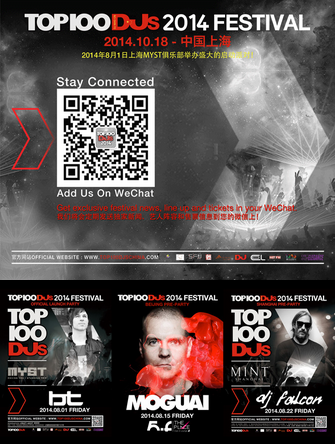The first lineup announcement for the second edition of China’s self proclaimed biggest #EDM festival is out. Budweiser Storm returns with an entirely predictable first announcement of Avicii, some of the Swedish House Mafia dudes (perhaps one of the ones that played last year, or is it the other two?), Afrojack, Dash Berlin (yes, we are still using DJ Mag Top 10 references as benchmarks of quality) and Knife Party. So far, so safe.
(Storm 2013 after-movie – right up Tom Cruise’s street)
2014 has been a big year for #EDM spending, with 2 of Chinese big music marketers (Heineken and Budweiser) tying their flag in no small way to the globally corporatised bastard child of electronic music. The moneymen here in China have also decided that #EDM is going to provide a massive ROI. After evident successes with Ultra Music Festival and Global Gathering in Korea, why would China not follow the same path, goes the thinking? 2014 has seen the emergence of a multitude of festivals devoted to electronic music, from Electric Circus, to the 3rd edition of the Great Wall Festival (organised by China’s own SFU Entertainment – a little too close to the SFX Entertainment name for our liking), to Release (organised by Modern Art Entertainment), to a slew of other such festivals that are planned for the autumn of this year, mostly in Beijing. And of course, there’s Budweiser Storm.
(Great Wall Festival – “Walls of inclusiveness” according to the anchor, who manages to squeeze a word out amongst a throng of laowai’s who’ve had a little too much pop and ice cream).
If you need any background, #EDM is the grand and gross commercialisation of sounds that have been on the fringes of music culture for the last 20 years, taken out through the front door by venture capitalists and private equity companies and floated on stock exchanges the world over. It is pop music for a generation of age-comers in love with designer drugs and CO2 cannons, made famous by the likes of Las Vegas, Electric Daisy Carnival, Tiesto and Robert SX Sillerman.
Arguably, the people that love #EDM now (in the West) are always the last to know. The music they listen to today has changed hardly at all since the mid-90’s – 808’s, massive drops, acid squelches (admittedly amended with a bit of mid-2000’s bass). All sound pretty much the same. A R3HAB set in 2014 would be remarkably similar to a Paul Van Dyk or Sasha set in 1994. So, while #EDM is now a pop music behemoth, there were 20+ years of evolution behind this sound and this style of partying, leading into what we have today. The people now paying $30 for a drink at Hakkasan or DC10 in Ibiza used to be the ones in drunken brawls outside top 40 clubs in Leicester Square, Chelsea in New York, Wrigleyville in Chicago. Remember London’s “place-to-be” China White? Yes, it was always shit, shallow and vapid. And now it’s #EDM.
So is this working in China? At first glance, this description of a superclub in Las Vegas could equally be a description of MYST or LINX in Shanghai, or 5th Floor in Beijing:
At Hakkasan, waitresses constantly weave through the crowd carrying huge, three-litre bottles of Grey Goose Vodka with LED lights inside, taking them to the VIP booths that circle the dancefloor.
So far, so good for our moneymen in China. Pretty much everything we’ve written so far could apply to the modern Chinese clubbing experience. Roped off access, raised VIP areas, sparklers in jeroboams, young men today repackaged as an erection in a vest (according to VICE). And yes, this is the Chinese clubbing experience also described by VICE.
This club experience has transitioned fantastically well from venue to festival in the US and Europe. Electric Daisy Carnival, Ultra, Creamfields, Global Gathering, Tomorrowland and many many others have been hosting raves-in-fields for years. When they started out 10 – 15 years back, they were much closer to the raves that preceded them than they are now, and the way they have developed from there is entirely logical, while slightly sad. In China, however, there has been no history of rave culture, only a short 2-3 year history of mainstream festivals (if that) and no real history of “dance” culture. Dancefloors are mostly non-existent – as we’ve all seen, club-goers all want to sit at tables, play games and be in the “right” spot. It’s about the cars parked out in front, about the high heels and bling.
 (M2, Shanghai. Little risk of breaking into a sweat.)
(M2, Shanghai. Little risk of breaking into a sweat.)
So far, the local response has been underwhelming. Attending Storm in 2013, Electric Circus and the Great Wall Festival over the last few months, it’s clear that the masses are not adopting. Estimates of 4,000 per day (Storm 2013), 6,000 (Great Wall Festival) and 1,500 (Electric Circus), largely white audiences (many pulled from the international school and international student populations) is a pretty poor early return for the huge amounts of private and corporate money invested so far. These same investors in the West were buying into established scenes – developed and proven audiences. In China, it’s another river-of-money crapshoot.
Scenes take years and years to gestate, to grow and to reach critical mass. It is rare (in fact we can’t think of a single example) to see private and corporate money actually “creating” one. If course, there is always a first time for everything, but in our experience, corporate time horizons are infinitely shorter than cultural ones.
What do you think? Do you believe deeply that the #EDM festival offering here in China is a current cultural phenomenon, or something for the future?
UPDATE:
Looks like Storm will be going up against this...

